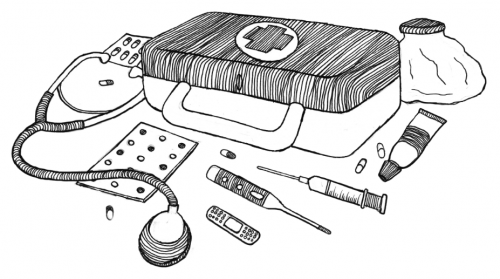
Article reposted from Mars’ Hill
Author: MADISON EVANS
They attend every practice and game, set aside time and energy to prepare beforehand, and stay late when they’re needed. Servant-hearted and hardworking, these team players are dependable and do what they are asked without complaint. Who, you may ask, is this most valuable player of the sports world? It is, of course, the athletic therapists.
So, what exactly is athletic therapy? The goal of athletic therapy is a quick and safe return to work and play. Canadian Athletic Therapists Association (CATA) notes that athletic therapists are best known for their “quick-thinking on-field emergency care of professional athletes”—treating bone, muscle and joint injuries is all in the job description of an athletic therapist.
In varsity sports, the presence of athletic therapy is vital for the success of the team. In the same way as it is said of children, it takes a village to raise a team—not only are there coaches and team managers waiting on the sidelines of basketball and volleyball games—also present on the sidelines are the athletic therapists. They physically pick up athletes when they are down, and put them back together again. An athlete’s quick return to the field, court or rink after an injury is reliant considerably on the skill of the athletic therapy team that athletes are able to make it back out onto the court or field again after sustaining an injury.
At Trinity Western University, there are two full time athletic therapists in the therapy clinic, one nearly-certified athletic therapy student completing her practicum, as well as 13 other TWU student-therapists who attend the practices and games of a particular Spartan team throughout the school year. The athletic therapists and student therapists meet once a week on Mondays, and attend a week of extra training before the school year starts. It is safe to say that the schedule of an athletic therapist is nearly as busy as that of the athletes they treat—they attend practices, ready to be on-the-scene of any injury that occurs, and help athletes prep for up to an hour and a half before games start. The time commitment can vary depending on the team, but student athletic therapists can spend up to 18 hours a week with their team—and that is before factoring in the hours spent travelling for games.
I had the opportunity to talk to Katia, one of the full-time athletic therapists, about her experience as an athletic therapist. After graduating in 2013, she completed her practicum and schooling in 2014. Between herself and Nat Ghobrial, the head athletic therapist at TWU, they can see up to thirty athletes per day—and these time slots fill up quickly! Not every appointment is a new injury assessment, however, and some athletes need regular appointments as they rehabilitate their injuries. Katia explained that, when it comes to determining when an injured athlete is fit to practice or compete, a discussion must happen between the athletic therapist, coach, and player. It is the athletic therapist’s job to provide the best information and argument for the athlete’s optimal road to recovery.
“The best part about athletic therapy is meeting people from different backgrounds, and different sports at different levels, and learning how to help them deal with their injuries,” Katia said. “In this field, you’re always learning new information from everyone around you—it’s a field that’s still evolving.” What is the most difficult part of her job? “It can be stressful sometimes,” she said. “Quick decisions can be hard to make, but with experience you get better, and are able to see the best paths to take in all situations […] and I still have things to learn: new ways to help, and ways to grow.”
Nicole Boulder injured her knee during a game in early November, and has been in the athletic therapy office almost every day since. “They carried me off the field,” Nicole recalled of the day she was injured. Nat and Sarah, two student athletic therapists, were at the game that day. “I already knew [the athletic therapists]; it was almost comforting, in a sense,” Nicole said. “I wasn’t alone on the ground—I had two people I knew were capable of taking care of me there on the field.” A major injury is a difficult roadblock for anyone to deal with, but Nicole remembers that she was worried about sustaining an injury while away from home. “I don’t have family here,” she said. Athletic therapy has become a huge source of support for Nicole through her knee injury and surgery, helping her out on her road to recovery. “Nat has become a really important person to me. I couldn’t imagine doing this without her and the rest of the athletic therapy team.”
